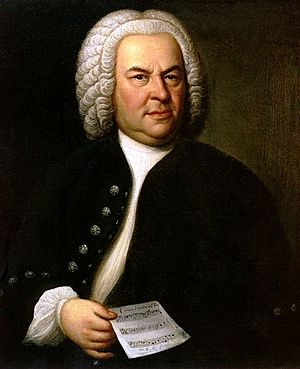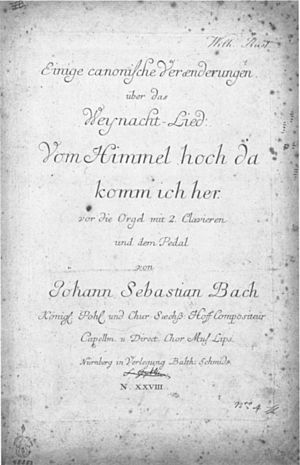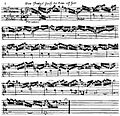Canonic Variations on "Vom Himmel hoch da komm' ich her" facts for kids

The Canonic Variations on "Vom Himmel hoch da komm' ich her" (which means From Heaven above to Earth I come), BWV 769, is a famous piece of music for the pipe organ. Johann Sebastian Bach wrote it. To play this music, an organ needs two keyboards (called manuals) and pedals for the feet.
This piece has five "variations." All the music is based on a Christmas hymn called “Vom Himmel hoch.” This hymn was very well known to people who went to the Lutheran church where Bach was the organist.
Bach wrote this music in Leipzig in 1747. He had just joined a group called Mizler's Music Society. The piece was printed in 1747. Another version was published later, which was a handwritten copy by Bach himself. This copy also included other organ music, like his six trio sonatas. In this later version, Bach moved the fifth variation to the middle of the piece.
Contents
Why Bach Wrote This Music
In June 1747, Bach became a member of a group called the "Corresponding Society for the Musical Sciences." This group had 14 members when Bach joined. They studied and encouraged people in Leipzig to compose music.
To celebrate joining, Bach gave the society a copy of his Canonic Variations. He also gave them a portrait of himself. This portrait, painted by Elias Gottlob Haussmann, shows Bach holding another piece of music that uses a lot of canon.
The five variations in “Vom Himmel Hoch” are special. They are not like typical musical variations. Usually, variations are just the main tune played with fancy decorations. But in this piece, each variation uses a musical technique called a "canon."
A canon is like a musical round, where different parts play the same melody but start at different times. Bach loved composing with canons, especially later in his life. Many of his works from that time use canons, like the Goldberg Variations and Musical Offering.
The Canonic Variations are based on the Christmas Hymn "Vom Himmel hoch, da komm ich her." Both the words and the melody were created in 1539 by Martin Luther. Bach had used this chorale (hymn tune) before in other pieces. You can hear it in his Christmas Oratorio and his Magnificat. It's also in some of his organ preludes. One short prelude from his Orgelbüchlein (Little Organ Book) is often played on radio and TV in Britain every Christmas Eve at the end of the famous carol service from King’s College, Cambridge.
The Music Explained
There are five variations in this piece:
Variation I
This variation is a two-part canon. It's played between the right hand and the left hand. It's called a "canon at the octave." This means the second part starts eight notes lower than the first part. The hands play on different keyboards of the organ. This makes them sound like two different instruments playing a duet.
The main hymn tune (called the cantus firmus) is played by the pedals. It uses long notes, with pauses between each part of the tune. The music played by the hands sounds a bit like the hymn tune too. It starts with six notes going down. Bach might have done this on purpose to show Christ coming down to earth. This kind of "word-painting" is common in Bach's music. It's when the actual notes of the music show the meaning of the words from the original hymn.
Variation II
Again, there's a canon between the hands, and the hymn tune is in the pedals. Each hand plays only one note at a time, like a single instrument. This time, it's a "canon at the fifth." The right hand starts on a C note, and the left hand copies it half a bar later, starting on an F note (five notes lower).
This canon uses the first and second lines of the hymn. Near the end, the canon comes back but is syncopated. This means the rhythm is a bit off-beat. At the very end, the hands play a scale going up. Bach might have wanted this to sound like angels going up to heaven, or a soul rising.
Variation III
In this variation, the canon is between the left hand and the pedals. The canon moves mostly in quavers (eighth notes) and is based on the hymn tune. The right hand plays a free melody. It also plays the hymn tune in long notes at the very top.
Variation IV
This variation has a new, lively tune in the right hand. It moves very fast, often using demisemiquavers (thirty-second notes). It's also very syncopated. The lower part of the left hand plays the same tune in canon. But it plays at half the speed of the right hand. This is called "augmentation" (making the notes longer). The upper part of the left hand plays a freer melody. The pedals play the hymn tune in long notes. Three bars before the end, you can hear the BACH motif in the left hand. These are four specific notes that Bach often used to represent his own name.
Variation V
The last variation gets grander and grander. It builds to a big finish. It sounds best when played as the final variation, rather than in the middle as Bach had it in his handwritten copy.
At the start of this variation, the canon is simply the hymn melody. The right and left hands play it. But this time, the left hand plays the tune upside down (inversion). It's a "canon at the sixth." The right hand starts on C, and the left hand starts on E below (six notes lower). Later, it becomes a canon at the third. The pedals just play a bass part, like a continuo instrument.
In the next part, the right hand plays fast notes and is marked "forte" (loud). The pedals play the hymn tune. The lower part of the left hand plays the hymn tune upside down in canon at the second. Then the right and left hands switch parts, and there's a canon at the ninth.
In the very last section, also marked forte (loud), the pedal part plays the hymn tune upside down. At the very end, as the music gets louder and builds to a climax, it repeats the last line of the hymn tune. It finishes on the lowest pedal note, a low C. The hands play on the same keyboard. There's a "stretto," which means all the musical parts start the tune (or a version of it) quickly one after another. Right at the very end, we hear the BACH motif again.
Conclusion
People often say Bach was a "mathematical" composer. This set of variations is a great example of how Bach liked to show off different ways of composing. It takes a lot of skill to write complicated canons like these, and still make the music sound beautiful. The description of the music might sound very complex, but you can enjoy the music without understanding all the techniques Bach used. Still, it's always amazing to see how Bach put all these clever ideas together!
Images for kids
-
Martin Luther: Vom Himmel hoch da komm' ich her, Bapst Gesangbuch in Leipzig, 1567
-
The small organ in the Thomaskirche in Leipzig, where Bach was organist and kantor 1723–1750. The organ, with its gilt Bach monogram, is a reconstruction by Gerald Woehl of a baroque organ played by Bach in the Paulinerkirche
-
Engraving of the Thomaskirche and Thomasschule in Leipzig in 1723, where Bach was appointed Thomaskantor
-
Annunciation to the Shepherds, English stained glass, c. 1340, Victoria and Albert Museum, London
-
Silbermann Organ, Sophienkirche, Dresden
-
Silbermann Organ, 1714, Freiberg Cathedral
-
Conclusion of fifth variation of BWV 769; in the original engraving the BACH motif did not occur in the inner parts in the last bar
-
Silbermann Organ, Hofkirche, Dresden

















